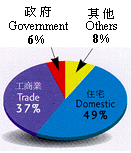
Several factors are taken into account in setting water charges, including the economic implications on the consumer price indexes, the financial impact on domestic users, as well as public views.
Also considered is the intention to eliminate any cross-subsidisation between domestic and non-domestic users, so that both sectors contribute their fair share towards meeting operational costs.
For the past four years, however, there has been no increase in most fees and charges for water, and this freeze has been further extended for six months from March 1999.
Adjustments were made in 1996 for some uses, such as for miscellaneous services and services for ocean liners.
As a result, there have been only marginal increases in revenue from chargeable supplies since 1995. Because revisions of charges were often set close to the rate of inflation rather than at recovery of full costs, water charges do not fully reflect the cost of production and rely on a high level of government subsidy through contribution from rates. Consideration, is however, being given to ways to reduce the subsidy.
Revenue in the waterworks accounts comprises chargeable supplies, supplies to government establishments, fees, licences and reimbursable work, and notional interest income from deposits.
| Finanical Year | 1989/90 | 1990/91 | 1991/92 | 1992/93 | 1993/94 | 1994/95 | 1995/96 | 1996/97 | 1997/98 | 1998/99 |
|---|---|---|---|---|---|---|---|---|---|---|
| Trade | 812 | 908 | 995 | 1,039 | 1,089 | 1,052 | 1,038 | 1,044 | 986 | 938 |
| Domestic | 436 | 567 | 664 | 748 | 926 | 1,012 | 1,118 | 1,138 | 1,185 | 1,245 |
| Government Uses | 90 | 97 | 97 | 108 | 127 | 141 | 164 | 150 | 143 | 149 |
| Others | 110 | 130 | 149 | 155 | 179 | 204 | 219 | 224 | 206 | 196 |
| Total | 1,448 | 1,702 | 1,905 | 2,050 | 2,321 | 2,409 | 2,539 | 2,556 | 2,520 | 2,528 |

For domestic consumption, water tariffs are divided into four tiers, intended to provide a progressively increasing price structure to discourage unnecessary use. This enables costs recovered from extravagant users to subsidise the lower tiers.
In the first tier, a free supply of 12 cubic metres is provided for each household every four months. This is regarded as the minimum amount of water required for health and hygiene by reference to average household-size in public housing.
The second tier of 31 cubic metres for each household for four months is charged at cost, after taking into account the government subsidy through rates.
The third tier being the next 19 cubic metres every four months for each household is charged on a non-subsidy basis.
The fourth tier, for the remainder, is charged at a punitive rate of roughly 40 per cent above the third.
The following water rates have been in effect since February 1995 except the rate for Ocean-going shipping purposes which was effective from July 1996.
| Category | Consumption | HK$ (Per Cubic Metre) |
|---|---|---|
| Domestic Use | Cubic metres every 4 months | Rate for every 4 months |
| First Tier | First 12 cubic metres | FREE |
| Second Tier | Next 31 cubic metres | $4.16 |
| Third Tier | Next 19 cubic metres | $6.45 |
| Fourth Tier | For the remainder | $9.05 |
| Non-Domestic Use | ||
| Trade | $4.58 | |
| Construction | $7.11 | |
| Ocean-going Shipping | $10.93 | |
| Non-Ocean-going Shipping | $4.58 | |
| Fresh Water for Flushing | Cubic metres every 4 months | Rate for every 4 months |
| First Tier | First 30 cubic metres | FREE |
| Second Tier | For the remainder | $4.58 |
| Sea Water for Flushing | FREE | |
The cost of domestic supplies of water comes to about 0.3 per cent of the average household expenditure. This figure is one of the lowest among the world's major cities and takes into account the 15% of domestic accounts (households) that do not have to pay for their water.
Water tariff for non-domestic users is set at the total production cost after taking into account the government subsidy through rates, such as those for trade purposes, or without subsidy through rates, such as for construction purposes.
Every year the Director of Water Supplies prepares a set of five-year projections on the basis of forecasts of income and expenditure levels, capital spending, outlays, growth of water consumption as well as inflation.
The five-year projection forms a model on which various scenarios of water tariff revision are tested. By this process a draft proposal is worked out for the next year's tariff revision.
The proposal for water charges is then put up for consideration in the meeting of the Waterworks Accounts Committee, chaired by the Secretary for the Treasury. Other members of the Committee are the Director of Water Supplies and senior officers from the Finance Bureau, the Works Bureau, the Treasury and Water Supplies Department.
The Committee usually meets in November each year to examine the Waterworks Operating Accounts, Five-year Projections, and proposals for revising charges.
A formal proposal is then drafted and submitted for consideration by the Executive Council. If approved, an amendment legislation to the Waterworks Regulations is tabled at the Legislative Council for final approval to become law.